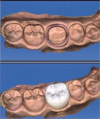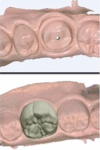Marginal fit of all-ceramic crowns fabricated using two extraoral CAD/CAM systems in comparison with the conventional technique
- PMID: 28352204
- PMCID: PMC5358961
- DOI: 10.2147/CCIDE.S130856
Marginal fit of all-ceramic crowns fabricated using two extraoral CAD/CAM systems in comparison with the conventional technique
Abstract
Objective: The purpose of this study was to determine the effect of two extraoral computer-aided design (CAD) and computer-aided manufacturing (CAM) systems, in comparison with conventional techniques, on the marginal fit of monolithic CAD/CAM lithium disilicate ceramic crowns.
Study design: This is an in vitro interventional study.
Place and duration of study: The study was carried out at the Department of Prosthodontics, School of Dentistry, Prince Sattam Bin Abdul-Aziz University, Saudi Arabia, from December 2015 to April 2016.
Methodology: A marginal gap of 60 lithium disilicate crowns was evaluated by scanning electron microscopy. In total, 20 pressable lithium disilicate (IPS e.max Press [Ivoclar Vivadent]) ceramic crowns were fabricated using the conventional lost-wax technique as a control group. The experimental all-ceramic crowns were produced based on a scan stone model and milled using two extraoral CAD/CAM systems: the Cerec group was fabricated using the Cerec CAD/CAM system, and the Trios group was fabricated using Trios CAD and milled using Wieland Zenotec CAM. One-way analysis of variance (ANOVA) and the Scheffe post hoc test were used for statistical comparison of the groups (α=0.05).
Results: The mean (±standard deviation) of the marginal gap of each group was as follows: the Control group was 91.15 (±15.35) µm, the Cerec group was 111.07 (±6.33) µm, and the Trios group was 60.17 (±11.09) µm. One-way ANOVA and the Scheffe post hoc test showed a statistically significant difference in the marginal gap between all groups.
Conclusion: It can be concluded from the current study that all-ceramic crowns, fabricated using the CAD/CAM system, show a marginal accuracy that is acceptable in clinical environments. The Trios CAD group displayed the smallest marginal gap.
Keywords: all-ceramic crowns; conventional impression; extraoral scanner; optical impression.
Conflict of interest statement
Disclosure The author does not have any financial interest in the companies whose materials are included in this article and reports no conflicts of interest in this work.
Figures




References
-
- Beuer F, Schweiger J, Edelhoff D. Digital dentistry: an overview of recent developments for CAD/CAM generated restorations. Br Dent J. 2008;204(9):505–511. - PubMed
-
- Brawek PK, Wolfart S, Endres L, Kirsten A, Reich S. The clinical accuracy of single crowns exclusively fabricated by digital workflow – the comparison of two systems. Clin Oral Investig. 2013;17(9):2119–2125. - PubMed
-
- Eames WB, O’Neal SJ, Monteiro J, Miller C, Roan JD, Jr, Cohen KS. Techniques to improve the seating of castings. J Am Dent Assoc. 1978;96(3):432–437. - PubMed
-
- Hollenback GM. A practical contribution to the standardization of casting techniques. J Am Dent Assoc. 1928;15(10):1917–1928.
-
- White SN, Ingles S, Kipnis V. Influence of marginal opening on micro-leakage of cemented artificial crowns. J Prosthet Dent. 1994;71(3):257–264. - PubMed
LinkOut - more resources
Full Text Sources
Other Literature Sources
Research Materials
Miscellaneous

